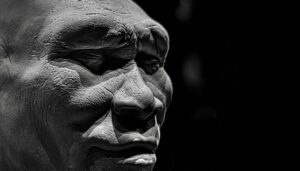
For most people, the Turkana Basin in northwestern Kenya is a fiercely inhospitable place. It is hot and dry — an arid, desert-like scrubland. At its center lies Lake Turkana, an enormous, expansive, alkaline body of water that has gained the apt description as the world’s largest permanent desert lake. There are no major resorts along its shores. Though rich as a source of fishing for the local economy, it’s flats team with Nile crocodiles and its shores are abundant with scorpions and carpet vipers. But this lake lies front-and-center within a region the geology of which has yielded one of the world’s great treasure-house landscapes of exposed beds teaming with fossils extending as far back as the Cretaceous period. The unforgiving environment was thus no barrier to the teams of paleontologists, geologists and paleoanthropologists that found their way here over the decades to explore and survey the landscape. And it was along the dried up Nariokotome river bed not far from the lake when, in 1984, eagle-eyed goat herder and fossil hunter, Kamoya Kimeu, spied a peculiar skull fragment. Kamoya honed his skills and reputation over the years in the employ of the renowned fossil hunting paleoanthropologist team of Mary and Richard Leakey. Kimeu knew what he was doing.
In time, through survey and careful excavation, the skull fragment turned out to be just one of 107 other bones, all members of the skeletal remains of a single individual animal….
A hominin.
Turkana Boy
The remains represented an almost complete skeleton. Once pieced together, it revealed what for its time was a startling new hominin discovery. The cranium was small, indicating a brain that was only two thirds the capacity of modern humans. The interior of the cranium featured asymmetry of a longer left brain over the right, suggesting the possible beginnings of the physiological capacity for speech.

Full Turkana Boy skeleton, as exhibited at the American Museum of Natural History, New York. Mike Peel , CC BY-SA 4.0, Wikimedia Commons
The post-cranial skeletal features featured shoulders, arms, torso with a barrel-shaped chest, a tucked-in pelvis, and legs that more closely resembled those of modern humans, as opposed to modern apes, though the feet were missing. Assembled and stretched lengthwise, the body frame and skull measured about 5’3”, with a breadth that suggested about 103 pounds at the time the individual was alive. Analysis of the bones indicated that this was a male youth around 8 or 9 years old. Perhaps most significant about the boy was that he likely moved with an erect gate — he was fully bipedal. The body structure and full bipedality contrasted sharply with most hominin fossil discoveries previously discovered, such as the famous ‘Lucy’ australopithecine fossil skeleton unearthed at Hadar, Ethiopia by Donald Johnson 10 years earlier in 1974. The discovery team named him, for ease of popular reference, Nariokotome Boy, after the location of the discovery. Alternatively, he was nicknamed Turkana Boy, and this has been the name most used by the popular media.
The Significance of the Discovery
All in all, it was a remarkable discovery. Now scientists had unearthed an almost complete individual (the most complete early human skeleton ever found) that was clearly not like the more ape-like front-page-making australopithecine discoveries recovered previously from various sites in East Africa and South Africa. This was, according to the discoverers, a member of the genus Homo, and more specifically, a Homo erectus — a hominin species generally thought to exhibit characteristics more closely resembling those of, and suggesting a functionality more like, Homo sapiens.
Perhaps most significant was the date of the find. At 1.5 millions ago, it was among the oldest Homo erectus discoveries. Moreover, this was important in developing paradigms for human evolution because Lucy, as a partially complete specimen discovered at Hadar, Ethiopia and dated to 3.2 million years ago, was an australopithecine ( a different and more ancient genus) that exhibited a starkly different morphology. Though much smaller than Turkana Boy, she sported longer (relative to the body) arms, curved fingers, suggesting the adaptation to climbing trees like other primates, and a funnel-shaped chest much like a chimpanzee’s. However, her feet, knees, hips, and the position of her head upon her neck were, like Turkana Boy, adapted for at least some bipedal movement. In contrast to Turkana Boy, her brain case was only one-third the size of the modern human brain.
_____________________________
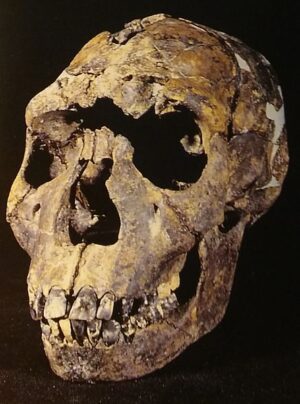
Turkana Boy skull. BAHN, Paul G, Public Domain, Wikimedia Commons
_____________________________
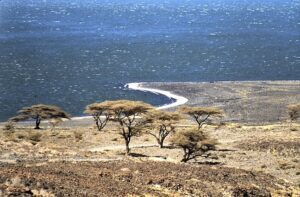
View of Lake Turkana. wfeiden, CC BY-SA 4.0, Wikimedia Commons. The landscape around Lake Turkana at the time of Turkana Boy was much wetter than it is today. A larger ancient paleolake existed instead of the current lake, surrounded by a savannah-like landscape of grasslands and scattered trees. Many scientists suggest that it was the transition from an environment thick with vegetation to that of a savannah that presented new challenges and impacted, in part, the course of human evolution, from the more ape-like ancestral predecessors to the bipedal, tool-making-and-using hominins that adopted a more varied diet of meat-eating, selective plant foraging, and more sophisticated scavenging and hunting strategies.
_____________________________
Other Finds
Astonishing as the Turkana Boy discovery was, it was certainly not the only Homo erectus fossil find emerging from East Africa. Most notable historically among the discoveries were three specimens; one, a nearly complete cranium designated with catalogue number KNM ER 3733; another, a partially complete cranium, designated KNM ER 3883, and the third, KNM ER 42700, also a partial cranium. KNM ER 3733 was discovered in 1975 at Koobi Fora, just east of Lake Turkana by Richard Leakey and his field worker Bernard Ngeneo. This cranium, dated to 1.78–1.48 million years ago, was determined to be an adult female based on the comparatively less robustness, the extensive teeth-wear, the presence of third molars, and fused cranial sutures — all tell-tale signs of adulthood. The KNM ER 3733 cranium is considered among the oldest Homo erectus fossils ever found. KNM ER 3883, discovered in 1976 also by Richard Leakey at Koobi Fora, has been dated to 1.6 million years ago. Larger and more robust than KNMR 3773, it is thought to represent an adult male. Notably, it shows a cranial capacity greater than 804 ml, suggesting a brain comparatively larger than most Homo erectus finds. Finally, KNM ER 42700, a cranium of a young adult individual, was discovered in northern Kenya, notably not far from where fossils of late-dated Homo habilis were found. Dated to about 1.55 million years ago, this fossil find has shifted thinking about hominins among scientists, suggesting that individuals or groups of Homo erectus and Homo habilis coexisted or overlapped in the same region at the same time.
______________________________
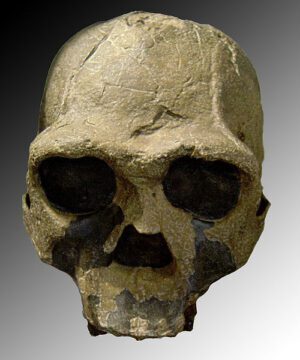
KNM-ER 3733 discovered by Bernard Ngeneo in 1975. CC BY-SA 4.0, Wikimedia Commons
______________________________
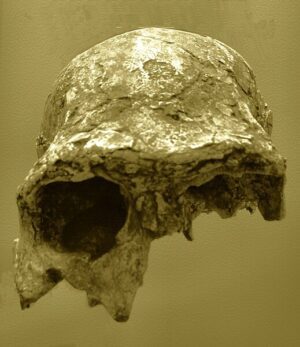
Homo erectus KNM-ER 3883 (replica, Senckenberg Museum, Frankfurt am Main, Germany). Gerbil, CC BY-SA 4.0, Wikimedia Commons
______________________________

KNM-ER 42700. Cast exhibited at the David H. Koch Hall of Human Origins at the Smithsonian Natural History Museum. Ryan Somma, CC BY-SA 4.0, Wikimedia Commons
______________________________
********
East Africa has long been thought to be the exclusive African domain for the earliest emergence of Homo erectus. But a remarkable discovery made in 2016 suggested otherwise….
[See the full article with a premium subscription to Popular Archaeology.]
Cover Image, Top Left: Facial reconstruction of Homo erectus. Werner Ustorf, CC BY-SA 4.0, Wikimedia Commons
Advertisement

EXPLORE THE ANCIENT ETRUSCANS IN PERSON!
Experience a unique, up-close-and-personal hike among ancient hilltop towns in central Italy. You will walk the sensational countryside of the regions of Umbria and Tuscany, soaking in important sites attesting to the advanced Etruscan civilization, forerunners of the ancient Romans; imposing architectural and cultural remains of Medieval Italy; local food and drink; and perhaps best of all — spectacular scenic views! Join us in this collaborative event for the trip of a lifetime!



